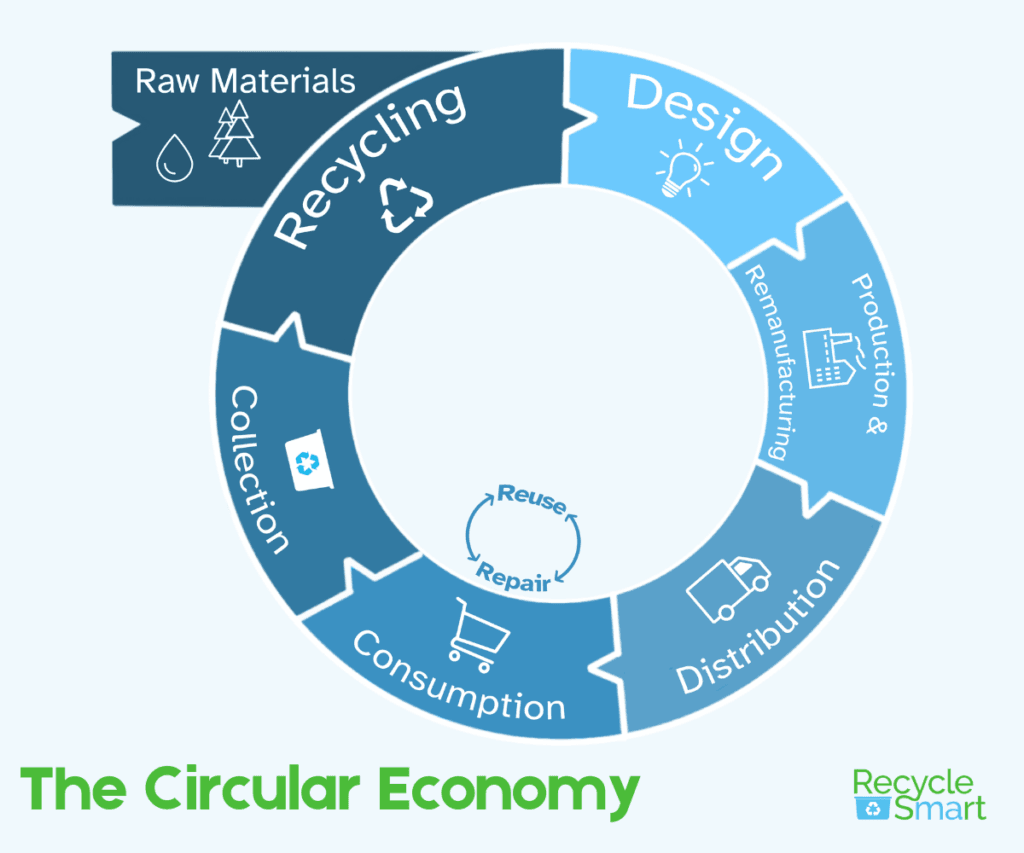
A circular economy (also called circularity) means keeping materials that already exist out of the trash and in use for as long as possible.
Everything we buy has an environmental impact before it reaches us. These “upstream” impacts happen during the first three steps in the life cycle of our stuff: raw material extraction, product manufacturing, and transportation to retailers. Tied up in these processes are things we often overlook, such as habitat destruction, harm to vulnerable communities, water pollution, and close to half (45%) of global greenhouse gas emissions.
When we reuse and repair things, we make our items last longer, use fewer resources, and often save money. Once something can no longer be reused or repaired, we can recycle it and put existing materials back into production – bypassing the extraction step. In fact, recycling has contributed to a robust circular economy for decades. Aluminum cans, glass, and cardboard can be recycled back into what they originally were over and over again. When you think about it, it just makes sense to keep stuff circulating.
Help Close the Loop
You can help promote circularity by buying products made from recycled materials! In doing so, you support strong markets that keep plastics, metals, glass, and more in use. It’s also why recycling right matters—putting things in the right bin means Materials Recovery Facilities (MRFs) spend less time wading through contamination and more time sending stuff to recyclers.
Despite gloomy headlines, recycling is real and happening in Massachusetts. In fact, 90% of recyclable materials sent to MRFs are captured, baled, and sold to recyclers. That’s a pretty great stat! The trick is to make a habit of recycling the right stuff. Believe it or not, Massachusetts residents still don’t recycle 100% of what could go in their bin. Help close the gap by always referencing MassDEP’s handy Smart Recycling Guide!
Designing for Circularity
There’s one key part of the circular economy that often gets overlooked: design. Designing for circularity means creating products that are durable, repairable, and eventually recyclable. It also means finding ways to make products with less energy and waste.
Consider the humble aluminum can. With its deceptively simple design, it is simultaneously lightweight, portable, protective, and recyclable. The great thing about aluminum cans is that while they are sometimes made into other products like foil or pie plates, they are often recycled right back into new cans.
Aluminum cans can travel through the entire recycling process—from sorting and processing to manufacturing and back on a market shelf—in as little as 60 days. Making recycled aluminum also takes a fraction (only about 5%) of the energy needed to make new aluminum. What’s more, it can be recycled over and over again in an almost infinite loop. One can has likely lived many lives and will go on to live many more as long as it keeps getting recycled!
Aluminum cans are just one example of circular design, and it’s so popular that big-name brands are switching to it! Want to learn more? Check out the Ellen MacArthur Foundation’s explainers on designing for circularity.
More Circularity in Massachusetts and Beyond
There are many municipalities, businesses, and organizations working to support a circular economy in and outside of Massachusetts. Here are a few:
- HandUp, located in New Bedford, collects used mattresses for recycling or resale. Mattress fabric is ground up and used in dog beds, foam becomes carpet padding, and steel is recycled. Mattresses in good condition are cleaned, sanitized, and resold.
- Habitat for Humanity Restores and other thrift stores keep thousands of tons of clothing, furniture, building materials, and household goods in circulation every year.
- Erving Industries, located in Erving, creates tissues and paper towels from 100% recycled paper.
- NexTrex turns plastic bags and wrap into patio furniture. They collect a variety of stretchy plastics by partnering with grocery store chains across the United States. Check out their list of acceptable items.
- Driscoll’s, the world’s largest berry company, works with its packaging suppliers to increase the amount of recycled plastic in its clamshell containers. This has helped strengthen markets for plastics that would otherwise be trashed. Read this article to learn more.
Many Massachusetts cities and towns host swap shops, reuse events, and repair cafes. Learn more about these and other reuse opportunities near you.
You Can Help Close the Loop
We all make choices, and collectively those choices add up to a big impact. Here are some ways to get into the circular economy spirit!
- Consider buying products made with recycled materials. These products create a market for our recyclables by showing manufacturers we want recycled material in new things.
- When buying something, consider the container or packaging it’s in. Can you skip single-use packaging or replace it with your own reusable or refillable container?
- Reuse and repair as many times as you can. Reuse is becoming easier, with local swap shops, social media groups, and secondhand stores offering affordable, pre-loved items. Likewise, the internet is full of repair guides and videos for all sort of things (electronics included).
- Explore upcycled items. There’s a wide world of businesses and artists out there turning trash into treasure! From earrings made of bike tires to backpacks woven from plastic bottles, there are many upcycled goods to choose from.
Know before you throw. Putting waste in the right bin means good materials are more likely to find their way back into the economy. You can always check the Recyclopedia when in doubt!
This content was provided by MassDEP's RecycleSmart MA newsletter.


